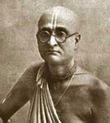![[Home Page]](../grfx/bml_logo.gif)

Srila Bhaktisiddhanta
Saraswati Thakura Page
Sri Caitanya is the Divine Personality Himself. His associates share His divine nature. Sri Krsna Caitanya is an extended subject. All the six divine forms have to be worshipped if is the intention to worship Sri Caitanya.
The guru is one of His constituents. It is necessary to receive initiation from him. It is also necessary to be instructed by Him. As teacher, the guru has two forms. He guides from within. He also appears as a guide and instructor existing outside his disciples. Initiation is received from one person only. Instructions may be had form many gurus. Sri Kaviraja Goswami himself was instructed by the famous six Goswamins.
But all jivas are not liable to be eclipsed by the deluding potency. Those who are so liable are again distinct from the eternally free jivas. The eternally free jivas are inseparable associates of Nityananda. They are integrated part and parcels of Himself. They never fall into the clutches of maya. When Nityananda manifests His appearance on the mundane plane His inseparable constituents also appear in His company. They sometimes manifest their functions on this lower place in a visible form on the errands of Nityananda. They are Vaisnavas whose subordination to Nityananda is natural and ingrained in their nature. It is not necessary for such souls to undergo the process of enlightenment for being restored to the spiritual plane. Unless this fact is born in the mind the conditioned soul may be tempted to undervalue the constant guidance of the guru on the hypocritical plea of following in the footsteps of the eternally free pure devotees. Those, therefore, who suppose that deliverance from the bondage of this world should be practicable without the constant guidance of the spiritual preceptor, confound the conditioned state with the free.
The guidance of the guru is no curtailment of one's spiritual freedom. Those who are eternally free also follow his guidance by the spontaneous undeviating impulse of their perfectly pure nature. Guidance of the guru is the only divine guidance. Only atheists who are by their choice opposed to the service of Godhead, can be consistent opponents of the obligation to serve the guru in the same unconditional way as one should be prepared to serve Godhead Himself. There is no difference between the two functions. If the claim of the one is denied it necessarily involves the denial of the claim of the other. Nityananda and His companions form one of the five groups of the associates of Sri Krsna Caitanya, whose distinctive function is that of the guru.
The guru admits to the service of Krsna. The next divine category is the bhakta or devotee. In this case also as in that of the guru, service of the divinity, which is the distinctive function of the bhakta, is not confined to him only. The servants have been divided into two classes viz., (1) servants other than consorts and (2) consorts. The guru has distinctive function as master. The servant has no distinctive function as master. This distinguishes the guru from the bhakta. The bhakta is also Godhead in the distinctive form of this servant to whom the guru manifests the divinity. The mercy of the bhakta enables the dissociable soul to receive the mercy of the guru. The guru and the bhakta are the inseparable divine counterparts of one another. The guru and the bhakta are thus two distinct entities forming the five categories. The avataras (descending divinities) are the third category. They have their distinctive functions in the maintenance and deliverance of jivas inclined to divine service. They have distinctive functions as master. The difference between the avataras and the divinity as master consists in this that the avataras are derivatives from the divinity possessing the plenary divine nature. The relation between the two is analogous to that between the original self-existing source-light and other shining lamps that have been lighted from the source. There is no substantive or magnitudinal difference between the two. But there is distinctiveness in function. The avataras have distinctive natures of their own. But the divinity is their common source possessing all their distinctive functions in a synthesis which distinguishes Him from the avataras without suffering any diminution of His divinity by the eternal parallel coexistence of the distinctive activities and personalities of the avataras as divinities.
Another divine category is the group of the divine manifestations. The manifestations are divine forms who are either identical with that of the divinity or of a distinctive nature. Krsna can appear simultaneously in the same form or in different forms to different persons and also simultaneously retain His own form. All these other forms are His own manifestations.
The fifth divine category is divine power. Divine power is the Predominated Moiety of the divinity who is Predominating, Whole. Sri Radhika is the predominated Counter-Whole of Sri Krsna. Sri Radhika has Her duplicates and constituents who are also of the nature of plenary powers of the divinity. She also directly serves Sri Krsna in an infinity of ways in Her countless distinctive plenary and secondary forms.
The pedant is disposed to be skeptical by reason of a lurking belief that it is the look-out of the divinity to make Himself known to Him. But the jiva is a dissociable particle of the divine essence with the onus of choosing for himself from among the alternatives of a serving, a neutral and disobedient career, his own relationship to the divinity. He cannot escape the privilege of exercising his responsibility except by conscious self-deception or by hypocrisy.